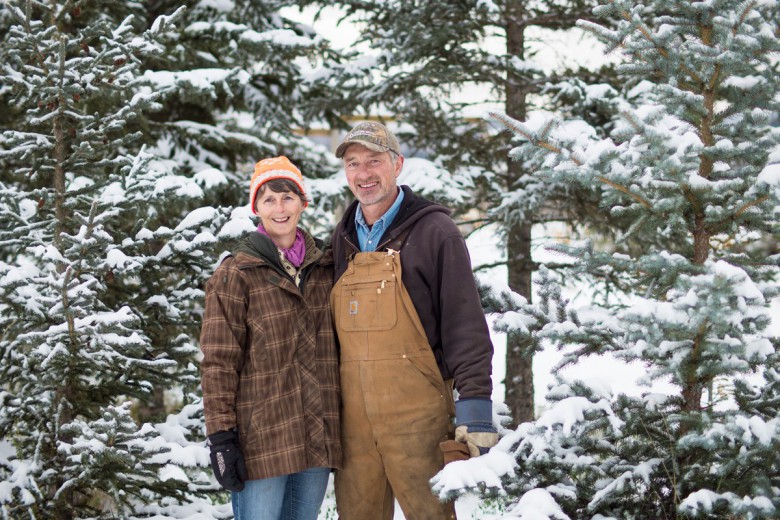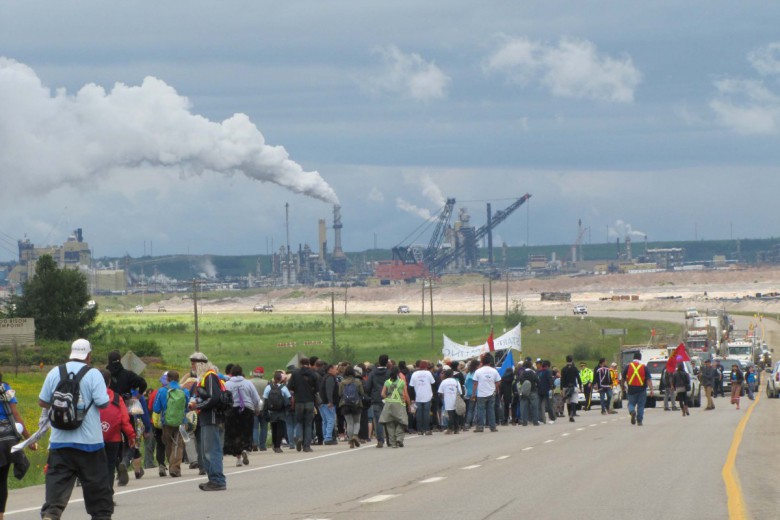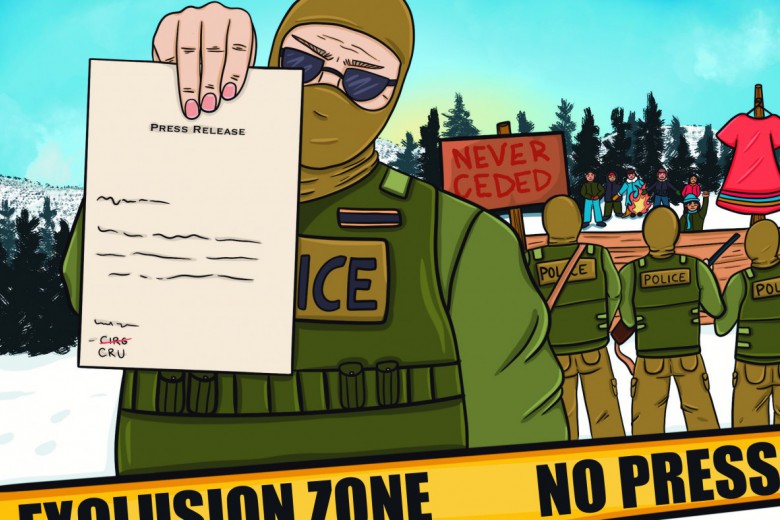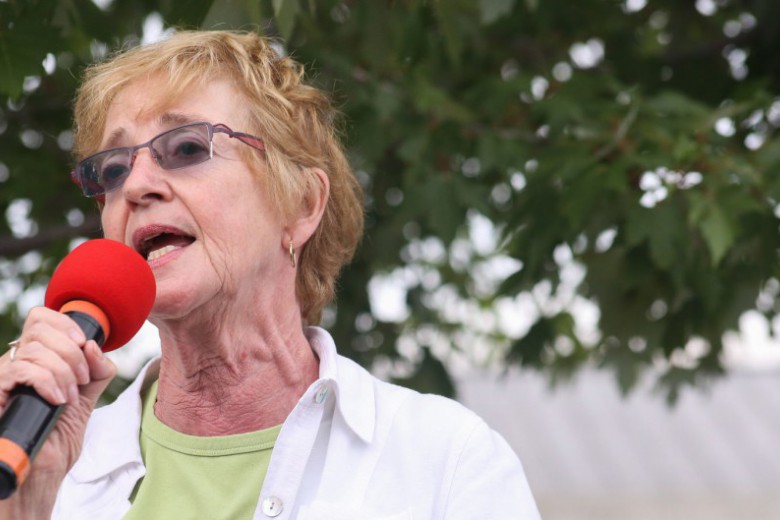
Introduction by Briarpatch Staff
On July 27, 2011, a group of people from communities in northern Saskatchewan, including a large youth contingent, began an 820-kilometre walk from the village of Pinehouse to the provincial legislature in Regina. Over 20 days, the walkers visited 12 communities between Pinehouse and Regina. The purpose of their journey was to raise awareness about the storage and transportation of nuclear waste in the province, and to oppose a proposed nuclear waste dump near Pinehouse.
The walk was organized by the Committee for Future Generations, which was formed in spring 2011 after residents of the northern Saskatchewan communities of Pinehouse, English River and Creighton found out that their administrations, along with those of a few communities in northern Ontario, had expressed interest in hosting a nuclear waste repository.
Three weeks after the discovery, the newly formed Committee for Future Generations hosted a public forum where 200 attendees from 12 northern and 8 southern communities, representing a diversity of ages, backgrounds and organizations, voted unanimously to lobby government for a ban on nuclear waste storage and transportation in Saskatchewan. The walk was organized with the intention of building solidarity among the province’s residents to push for a legislated ban.
Serious questions have been raised about the unethical means by which the industry-driven Nuclear Waste Management Organization (NWMO) is attempting to fulfill its duty to consult potentially affected Aboriginal communities, as ordered by the Supreme Court of Canada. In addition to paying hundreds of dollars in per diems to elders to liaise between their communities and NWMO, the organization also brought elders and youth together under the pretext of an elders’ circle on suicide prevention, which in fact turned out to be a blatant promotion for the storage of nuclear waste in northern Saskatchewan. Max Morin of Beauval, Saskatchewan, had been invited to attend as an elder. “After two hours of pouring our hearts out, sharing in a talking circle,” Morin states that the NWMO facilitator wrote “duty to consult” on the flip chart and abruptly turned the conversation to nuclear waste storage. “‘NWMO’ was written on the flip chart too, and all of a sudden it was all about NWMO.” Morin reports that 11 elders walked out of the meeting in protest.
The walkers arrived in Regina on August 16, where they were joined by several hundred people for the last few kilometres of their walk. Although the committee had invited Premier Brad Wall to meet with them, on arrival at the provincial legislature only a lone government staffer appeared to quickly shake hands before retreating back into the building.
Nonetheless, the walk succeeded in bringing opposition to a nuclear dump into the mainstream media, and in building province-wide solidarity against the storage and transportation of nuclear waste in Saskatchewan. Don Kossick caught up with some of the walkers a few weeks after the walk. This is an excerpt from his interview with Doreen Docken, Max Morin, Debby Morin and Victor Mispounas.
Tell me about your motivations for doing this walk.
Doreen: Before the walk started, I sometimes wondered, what am I thinking? I’m overweight, limited in my knowledge and I have lots of other things to do. But I had lived most of my life in an area that most people only dream of, with clear, clean water; air without impurities; smells of pine and birch as the wind whistles over the willows; cranes, pelicans, loons and eagles that talk to me throughout the day – pristine beauty. This was a land that I wanted to share with my children, grandchildren and their children, a land that they have every right to enjoy.
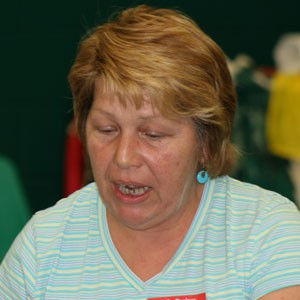
How did the walk go? Did it achieve what you wanted it to?
Doreen: We were about 10 in our core group, but we grew as we travelled. We learned a lot from others who have been involved in anti-nuclear work for over 30 years. They supported us, educated us and walked alongside us. I was inspired – inspired to educate friends, family and surrounding communities.
Debby: Our greatest treasures of that walk were the people that we met. We were really reminded that that’s where the real strength is. We were ready to go straight to Regina by ourselves if we had to, but we sure didn’t have to.

Victor: I didn’t know there were so many white people out there who were so caring. Before, I had nothing to do with white people. I didn’t trust them. Now I feel a whole lot different.
Max: It felt so great to make it to the legislature. Our expectation was to meet with the government there, and they didn’t really show. But by then, we’d woken up the whole province, and I think we achieved what we needed to to make this an issue of the province, of Saskatchewan – not just the north, not just the south, but all of Saskatchewan.
This is a beautiful Saskatchewan, and it should stay that way. Our rivers, our living skies, our trees, our land, our resources, our wildlife, our moose, our fish – that’s what we want to hang on to. We don’t want to be victims like those in Chernobyl and Japan. My heart goes out to those places.
During the walk, you gathered water from each community in a buffalo horn. What was the significance of that?
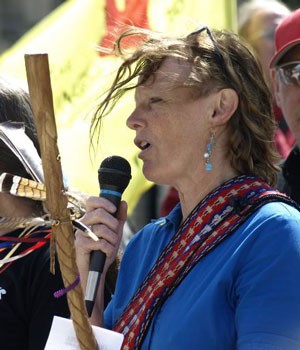
Debby: All of Saskatchewan is like a sponge that holds water. If you drop vinegar or something on one side of a sponge holding water, it will eventually spread throughout the whole sponge, and that’s exactly what would happen with a nuclear accident. Water unites us all.
We already have nuclear waste up here with the tailings that have been lying around. With the amount of cancers that have been happening, we would like to get some tests done on the radioactivity of the water up here. What we’re trying to prevent is more, not only more volume but more deadly waste from coming.
Collecting the water from the communities was part of the waking up, part of the educating. We sent out an invitation to a representative of each community we went to, to present us with a gift of their water, which they would pour into a buffalo horn. We started at Pinehouse with a prayer from an elder. We put tobacco in the lake and started. That was our first collection of water, followed by rivers and lakes in communities all the way down. The water in that container is a symbol of how we’re all united.
You have said that the walk wasn’t the end; it was the beginning. What’s been happening since the walk?
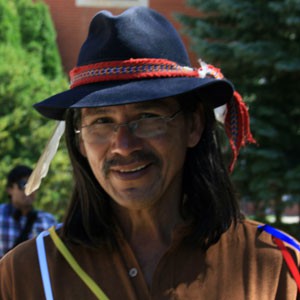
Max: NWMO has pushed back really hard. Because of the awakening inspired by the walk, NWMO has had to dig deeper into their pockets and spend a little bit more money on organizations, groups and communities, to stay ahead of the game. Our committee and the northern communities it represents, we’re not rich, but the message is being passed around through grassroots. Moccasin telegraph, we’ll say.
Debby: Our petition to ban nuclear waste storage and transportation in the province now has more than 10,000 signatures. Including the 5,000 signatures submitted by Clean Green Saskatchewan in April 2011, that’s 15,000 Saskatchewan residents and counting now petitioning the government to ban nuclear waste.
Doreen: Through the walk, we realized how little people in Saskatchewan knew, how much more education we need to do. That little awakening poke was not enough. The people of Saskatchewan need to know the truth, and I feel obligated as a mother, an educator and a human being to work as hard as I can to stop this insanity and to protect the blessings that have been given to me.
This interview first aired on Making the Links Radio and is available at www.makingthelinksradio.ca.
Since the interview, the Committee for Future Generations has continued its work to educate on the dangers of nuclear waste storage and transportation and strengthen opposition to the storage and transportation of nuclear waste in the province. It has accepted invitations to several speaking engagements with organizations such as Kairos, In-Equality, and Occupy, and has brought in experts for community information sessions.
On December 3, the Committee hosted a traditional thank-you feast for all the organizations and individuals who supported the walk. A joyful reunion of people from Pinehouse to Regina, the feast was followed by a strategy meeting, out of which emerged several task groups. In addition to saying “No” to nuclear waste, they also say “Yes” to renewable energy, and their plans include the promotion and development of a renewable energy economic base.


